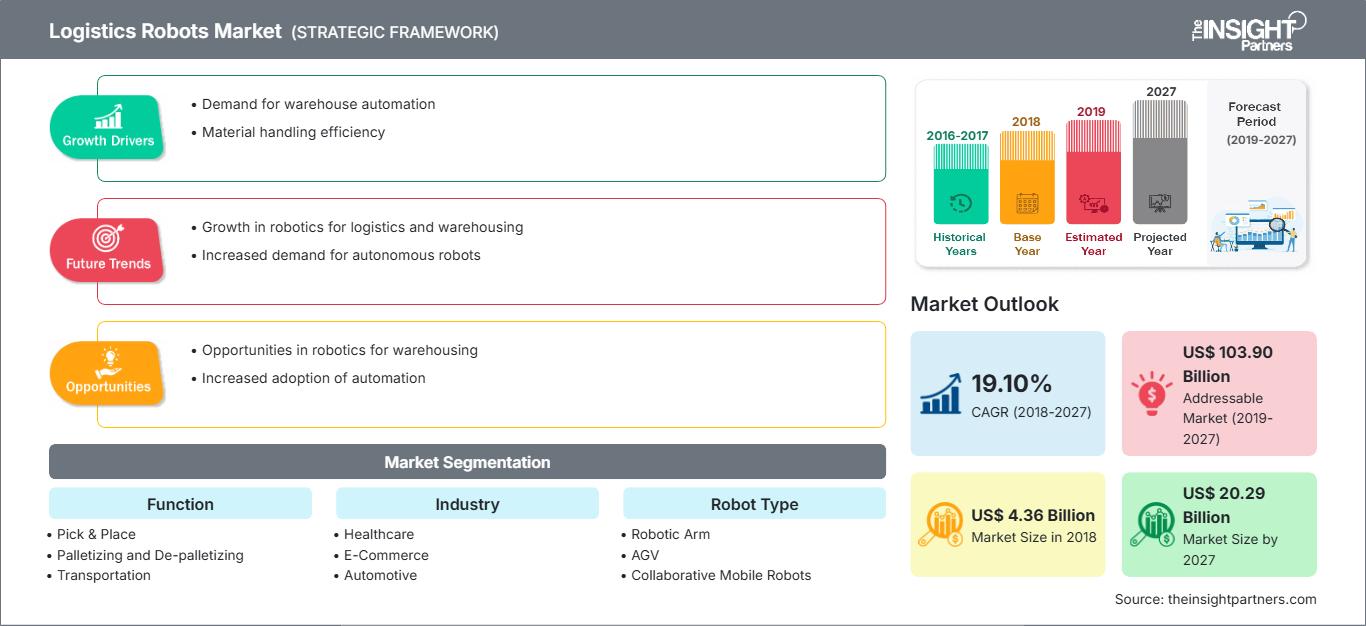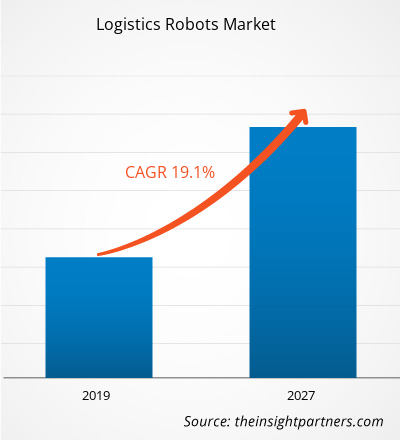Il mercato dei robot logistici è stato valutato a 4.356,2 milioni di dollari nel 2018 e si prevede che crescerà a un CAGR del 19,10% dal 2019 al 2027, raggiungendo i 20.293,4 milioni di dollari entro il 2027.
L'aumento del numero di aziende di logistica e magazzinaggio che si stanno concentrando sull'integrazione di robot per ottenere i vantaggi di maggiore efficienza, velocità e maggiori profitti per rimanere competitive sul mercato. L'adozione di tecnologie avanzate come la robotica per il magazzinaggio e la logistica è in crescita al fine di migliorare l'efficienza operativa a prezzi accessibili. Il mercato globale dei robot logistici è guidato da fattori come la crescente percentuale di popolazione anziana a livello globale, che porta alla carenza di manodopera e all'ampliamento delle reti della catena di approvvigionamento a livello globale, ma si prevede che gli elevati investimenti di capitale per l'implementazione di robot logistici limiteranno la crescita del mercato dei robot logistici durante il periodo di previsione. Tuttavia, la crescente automazione dei magazzini e il mercato consolidato nei paesi dell'Asia-Pacifico e dell'Europa offriranno probabilmente notevoli opportunità di crescita per migliorare la quota di mercato degli operatori del settore nel prossimo futuro.
Approfondimenti di mercato: la crescente percentuale di popolazione anziana a livello globale porta alla carenza di manodopera
La crescente percentuale di popolazione anziana in tutto il mondo è uno dei principali fattori di riduzione della manodopera in diversi settori. Ogni paese sta assistendo a un aumento del numero di anziani nella propria comunità. L'invecchiamento della popolazione è diventato uno dei fattori sostanziali delle trasformazioni sociali del XXI secolo in tutti i settori, che abbracciano sia il lavoro che i mercati finanziari. Tuttavia, diversi paesi come l'Italia, il Giappone e molti altri sono quelli che hanno registrato il numero più elevato di popolazione anziana, considerando una percentuale sostanziale della loro popolazione di età superiore ai 65 anni. Secondo l'OMS, si prevede che circa 2 milioni di persone in tutto il mondo avranno più di 60 anni entro il 2050, il triplo rispetto al 2000. L'aumento dell'invecchiamento della popolazione è la causa della carenza di manodopera. L'implementazione di robot logistici in diversi settori svolge un ruolo importante, poiché riduce i costi complessivi del processo, aumenta la produttività, migliora la sicurezza e riduce l'errore umano. I rapidi progressi tecnologici nei magazzini a livello globale si stanno concentrando sulle esigenze relative alle difficoltà incontrate dai processi della supply chain e garantiscono che la tecnologia utilizzata sia in linea con gli obiettivi aziendali. L'implementazione di robot in diverse unità, funzioni e fasi del ciclo di vita del prodotto rappresenta una sfida chiave per i magazzini odierni nel loro percorso di crescita, il che, a sua volta, darà impulso al mercato dei robot logistici nel prossimo futuro.
Personalizza questo rapporto in base alle tue esigenze
Potrai personalizzare gratuitamente qualsiasi rapporto, comprese parti di questo rapporto, o analisi a livello di paese, pacchetto dati Excel, oltre a usufruire di grandi offerte e sconti per start-up e università
Mercato dei robot logistici: Approfondimenti strategici

-
Ottieni le principali tendenze chiave del mercato di questo rapporto.Questo campione GRATUITO includerà l'analisi dei dati, che vanno dalle tendenze di mercato alle stime e alle previsioni.
Il segmento dei robot mobili collaborativi ha conquistato la quota maggiore nel mercato globale dei robot per la logistica. Vengono impiegati in diversi settori per svolgere diverse attività, come il confezionamento, l'asservimento macchine e la movimentazione dei materiali, poiché questi cobot sono sufficientemente efficienti da gestire sia operazioni pesanti che leggere. Sono estremamente accurati, flessibili e precisi. Inoltre, i cobot sono facili da manutenere e più facili da riconfigurare e riprogrammare. Questi robot possono anche gestire lavori delicati; inoltre, si adattano automaticamente alle incongruenze che si verificano durante i processi di produzione. I cobot sono in grado di raccogliere metriche critiche per fornire analisi integrate, insieme a report, per semplificare il processo decisionale che guida il mercato complessivo dei robot per la logistica.
Approfondimenti sulle funzioni
Il segmento dei trasporti ha conquistato la quota maggiore nel mercato globale dei robot per la logistica. Le merci sono pallettizzate e vi è una leggera variazione in diverse forme e dimensioni dei prodotti, che ha richiesto l'automazione per il carico e lo scarico di queste merci. La visione laser 3D è integrata con il nuovo software robotico, che aiuta gli utenti a visualizzare i diversi prodotti nei container, a determinare la sequenza ideale di carico/scarico e a eseguire il processo con elevata precisione. La robotica logistica, impiegata per spostare i ripiani, estrarre e sollevare i cestelli, allungare le forche sullo scaffale e riportarle nella posizione di destinazione, guida il mercato complessivo dei robot logistici.
Approfondimenti di settore
Il segmento della logistica esternalizzata ha conquistato la quota maggiore del mercato globale dei robot logistici. Questi fornitori di servizi logistici offrono diversi servizi, tra cui magazzinaggio, gestione dell'inventario, trasporto, distribuzione, evasione degli ordini e consolidamento delle merci. La crescente domanda di una gestione tempestiva delle consegne e di una riduzione dei costi di spedizione, con un'attenzione maggiore alla tenuta della contabilità dei materiali in magazzino, al core business e alla riduzione delle risorse aziendali, dovrebbe guidare il mercato dei robot logistici durante il periodo di previsione.
Diverse strategie di iniziativa di mercato vengono comunemente adottate dalle aziende per espandere la propria presenza a livello mondiale e soddisfare la crescente domanda. Questa strategia è osservata principalmente in Europa e nella regione Asia-Pacifico. Gli operatori presenti nel mercato dei robot logistici adottano una strategia di espansione e investimento in ricerca e sviluppo per ampliare la base clienti in tutto il mondo, il che consente loro anche di mantenere il proprio marchio a livello globale.
Approfondimenti regionali sul mercato dei robot logistici
Le tendenze regionali e i fattori che influenzano il mercato dei robot logistici durante il periodo di previsione sono stati ampiamente spiegati dagli analisti di The Insight Partners. Questa sezione analizza anche i segmenti e la geografia del mercato dei robot logistici in Nord America, Europa, Asia-Pacifico, Medio Oriente e Africa, America Meridionale e Centrale.
Ambito del rapporto di mercato sui robot logistici
| Attributo del rapporto | Dettagli |
|---|---|
| Dimensioni del mercato in 2018 | US$ 4.36 Billion |
| Dimensioni del mercato per 2027 | US$ 20.29 Billion |
| CAGR globale (2018 - 2027) | 19.10% |
| Dati storici | 2016-2017 |
| Periodo di previsione | 2019-2027 |
| Segmenti coperti |
By Funzione
|
| Regioni e paesi coperti |
Nord America
|
| Leader di mercato e profili aziendali chiave |
|
Densità degli attori del mercato dei robot logistici: comprendere il suo impatto sulle dinamiche aziendali
Il mercato dei robot logistici è in rapida crescita, trainato dalla crescente domanda degli utenti finali, dovuta a fattori quali l'evoluzione delle preferenze dei consumatori, i progressi tecnologici e una maggiore consapevolezza dei vantaggi del prodotto. Con l'aumento della domanda, le aziende stanno ampliando la propria offerta, innovando per soddisfare le esigenze dei consumatori e sfruttando le tendenze emergenti, alimentando ulteriormente la crescita del mercato.

- Ottieni il Mercato dei robot logistici Panoramica dei principali attori chiave
- Braccio robotico
- AGV
- Robot mobili collaborativi
- Altri
Mercato dei robot logistici: per funzione
- Pick & Place
- Pallettizzazione e depallettizzazione
- Trasporti
- Imballaggio
Mercato dei robot logistici: per settore
- Sanità
- E-commerce
- Automotive
- Logistica esterna
- Vendita al dettaglio
- Beni di consumo
- Alimenti e bevande
- Altri
Mercato dei robot logistici: Per geografia
-
Nord America
- Stati Uniti
- Canada
- Messico
-
Europa
- Francia
- Germania
- Italia
- Regno Unito
- Russia
- Resto d'Europa
-
Asia Pacifico
- Cina
- India
- Corea del Sud
- Giappone
- Australia
- Resto dell'Asia Pacifico
-
Medio Oriente e Africa
- Sudafrica
- Arabia Saudita
- Emirati Arabi Uniti
- Resto del Medio Oriente e Africa
-
Sud America
- Brasile
- Argentina
- Resto del Sud America
Profili aziendali
- AGV International
- Clearpath Robotics
- Daifuku Co. Ltd.
- Fanuc Corporation
- Fetch Robotics Inc.
- Kion Group AG
- KNAPP AG
- Kollmorgen
- KUKA AG
- Toshiba Corporation
- Analisi storica (2 anni), anno base, previsione (7 anni) con CAGR
- Analisi PEST e SWOT
- Valore/volume delle dimensioni del mercato - Globale, Regionale, Nazionale
- Industria e panorama competitivo
- Set di dati Excel
Report recenti
Rapporti correlati
Testimonianze
Motivo dell'acquisto
- Processo decisionale informato
- Comprensione delle dinamiche di mercato
- Analisi competitiva
- Analisi dei clienti
- Previsioni di mercato
- Mitigazione del rischio
- Pianificazione strategica
- Giustificazione degli investimenti
- Identificazione dei mercati emergenti
- Miglioramento delle strategie di marketing
- Aumento dell'efficienza operativa
- Allineamento alle tendenze normative






















 Ottieni un campione gratuito per - Mercato dei robot logistici
Ottieni un campione gratuito per - Mercato dei robot logistici